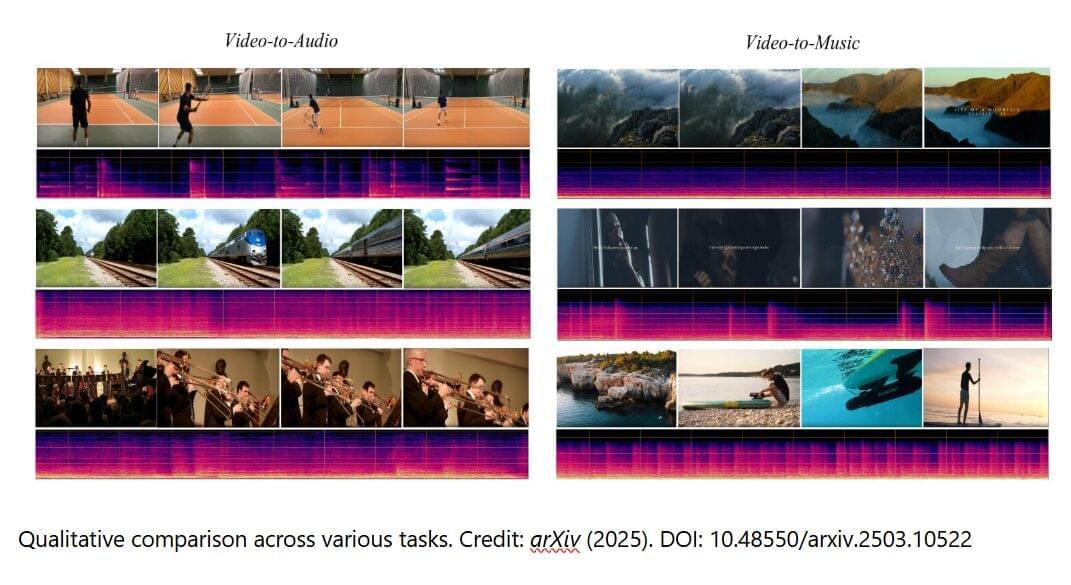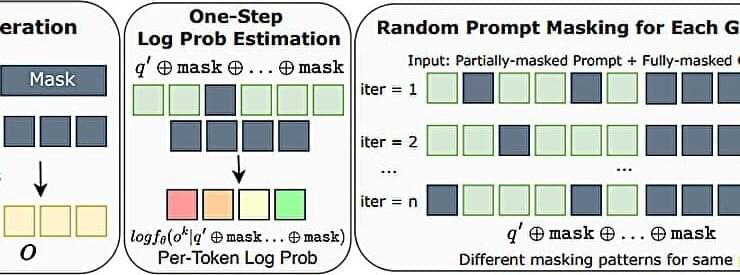NVIDIA’s AI Blueprint combines Black Forest Labs’ FLUX.1-dev as an NVIDIA NIM microservice, ComfyUI and Blender in a prebuilt workflow optimized for RTX AI PCs.
Category: robotics/AI – Page 238
Scientists use virtual reality for fish to teach robots how to swarm
Fish are masters of coordinated motion. Schools of fish have no leader, yet individuals manage to stay in formation, avoid collisions, and respond with liquid flexibility to changes in their environment. Reproducing this combination of robustness and flexibility has been a long-standing challenge for human-engineered systems like robots.

‘Explainable’ AI cracks secret language of sticky proteins
An AI tool has made a step forward in translating the language proteins use to dictate whether they form sticky clumps similar to those linked to Alzheimer’s disease and around fifty other types of human disease. In a departure from typical “black-box” AI models, the new tool, CANYA, was designed to be able to explain its decisions, revealing the specific chemical patterns that drive or prevent harmful protein folding.
The discovery, published in the journal Science Advances, was possible thanks to the largest-ever dataset on protein aggregation created to date. The study gives new insights about the molecular mechanisms underpinning sticky proteins, which are linked to diseases affecting half a billion people worldwide.
Protein clumping, or amyloid aggregation, is a health hazard that disrupts normal cell function. When certain patches in proteins stick to each other, proteins grow into dense fibrous masses that have pathological consequences.

Maarten Boudry | Will Humanity Be Subjugated by Superintelligent AIs?
*Apply to join Foresight Intelligent Cooperation program:* https://foresight.org/intelligent-cooperation/
A group of scientists, engineers, and entrepreneurs in computer science, ML, cryptocommerce, and related fields who leverage those technologies to improve voluntary cooperation across humans, and ultimately AIs.
*Maarten Boudry | Will Humanity Be Subjugated by Superintelligent AIs?*
Abstract: Some people are worried that if we ever create superintelligent AIs, they might turn against us—trying to subjugate humanity, wrest control, and grab resources, much like living creatures shaped by evolution. Dan Hendrycks from the Center for AI Safety has argued that AI systems are already undergoing a form of natural selection, facing ruthless market competition in the current AI race. Will this endow them with the instinctive drives for self-preservation and dominance typical of evolved creatures? In this talk, I push back against this evolutionary doom scenario, using the framework of “Darwinian spaces” by Peter Godfrey-Smith. A better analogy for AI evolution might be the domestication of animals. Just as humans have bred dogs to be friendly and obedient, we might shape AIs in similar ways, selecting for desirable traits like helpfulness and non-aggression. Even in a highly competitive AI race, AIs are unlikely to become selfish or power-hungry. That said, we do agree with the AI doomers on one point: if we allow AIs to “go feral” and be subjected to truly blind evolution—like wild animals competing in nature—that could become very dangerous.
Bio: Dr. Maarten Boudry is a philosopher of science and first holder of the Etienne Vermeersch Chair of Critical Thinking at Ghent University. He published over 50 academic papers and two edited volumes: Science Unlimited? (2018) and Philosophy of Pseudoscience (2013). He wrote six trade books in Dutch on science and philosophy, the latest one being The Betrayal of Enlightenment (Het verraad aan de verlichting, 2025). He’s also a Roots of Progress fellow and a regular contributor to Quillette, The Conversation, The Independent and Human Progress. Substack for English writings: maartenboudry.substack.com.
Bio: Simon Friederich is an associate professor of philosophy of science at the University of Groningen, the Netherlands. He is currently focused on the philosophy of quantum theory, trying to solve the quantum measurement problem along the lines envisioned by Einstein before advanced AI makes his efforts redundant. He has also worked on the philosophy of technology, notably on nuclear energy, sustainability, and advanced AI. His thoughts on these topics have been featured in German and Dutch media. With his wife and five kids he lives in a village in the North of the Netherlands.
*Speaker Link*
https://maartenboudry.substack.com/
*Timecodes*

Beyond Panpsychism: Consciousness as Informational Autonomy in a Universe of Flux
Long before human minds contemplated their own existence, information was already flowing. Not as bits in silicon, but as a fundamental flux of differentials in the fabric of reality itself. The universe, at its most elemental level, may be understood not merely as matter and energy, but as a vast information-processing system — a perspective that opens new avenues for understanding the enigma of consciousness. The question that has bedeviled philosophers and scientists alike is not simply what consciousness is, but how it emerges, and whether it represents something unique in the cosmic landscape or is merely a sophisticated expression of processes inherent to reality itself.
Panpsychism — the view that consciousness is fundamental and ubiquitous throughout the universe — has experienced a renaissance in recent philosophical discourse. Yet despite its elegant simplicity, it leaves crucial questions unanswered, particularly regarding the mechanism by which consciousness manifests in systems of varying complexity. This essay proposes that consciousness can be more productively understood as an autonomous region of information processing within a general field of information, a perspective that synthesizes insights from systems theory, information dynamics, the science of living systems, and recent research on microtubular functions to transcend traditional panpsychist frameworks.
To appreciate consciousness as an emergent property of information processing, we must first recognize information’s fundamental role in the universe. Wheeler’s famous dictum “it from bit” suggests that physical reality emerges from information (Wheeler, 1990). This perspective has been substantiated by advances in quantum information theory, which demonstrates that information is not merely about reality but constitutive of it. As Vedral (2010, p. 3) argues, “Quantum physics requires us to abandon the distinction between information and reality.” The quantum world reveals itself not as a collection of things but as potentialities and relationships — informational patterns that coalesce into what we perceive as physical reality.
Flying squirrel-inspired drone with foldable wings demonstrates high maneuverability
Unmanned aerial vehicles (UAVs), commonly known as drones, have already proved to be valuable tools for a wide range of applications, ranging from film and entertainment production to defense and security, agriculture, logistics, construction and environmental monitoring. While these technologies are already widely used in many countries worldwide, engineers have been trying to enhance their capabilities further so that they can be used to tackle even more complex problems.
Researchers at Pohang University of Science and Technology and the Agency for Defense Development (ADD)’s AI Autonomy Technology Center in South Korea recently developed a drone with foldable wings that could be more maneuverable than conventional drones. Their drone draws inspiration from the winged flying squirrel, a type of squirrel that uses loose flaps of skin attached from their wrists to their ankles to glide from tree to tree.
“The flying squirrel drone is inspired by the movements of flying squirrels, particularly their ability to rapidly decelerate by spreading their wings just before landing on trees,” Dohyeon Lee, Jun-Gill Kang and Soohee Han, co-authors of the paper, told Tech Xplore. “We initiated this research with the belief that, like flying squirrels, drones could expand their dynamic capabilities by utilizing aerodynamic drag.”

New model can generate audio and music tracks from diverse data inputs
In recent years, computer scientists have created various highly performing machine learning tools to generate texts, images, videos, songs and other content. Most of these computational models are designed to create content based on text-based instructions provided by users.
Researchers at the Hong Kong University of Science and Technology recently introduced AudioX, a model that can generate high quality audio and music tracks using texts, video footage, images, music and audio recordings as inputs. Their model, introduced in a paper published on the arXiv preprint server, relies on a diffusion transformer, an advanced machine learning algorithm that leverages the so-called transformer architecture to generate content by progressively de-noising the input data it receives.
“Our research stems from a fundamental question in artificial intelligence: how can intelligent systems achieve unified cross-modal understanding and generation?” Wei Xue, the corresponding author of the paper, told Tech Xplore. “Human creation is a seamlessly integrated process, where information from different sensory channels is naturally fused by the brain. Traditional systems have often relied on specialized models, failing to capture and fuse these intrinsic connections between modalities.”
Integrating Artificial Intelligence Into Existing Platforms We Use In Our Workflows! | The AI Bros
In this third episode of the AI Bros podcast Bruce and John talk about everything from how AI is being utilized in existing platforms, to Character AI’s sync…

Reinforcement learning boosts reasoning skills in new diffusion-based language model d1
A team of AI researchers at the University of California, Los Angeles, working with a colleague from Meta AI, has introduced d1, a diffusion-large-language-model-based framework that has been improved through the use of reinforcement learning. The group posted a paper describing their work and features of the new framework on the arXiv preprint server.
Over the past couple of years, the use of LLMs has skyrocketed, with millions of people the world over using AI apps for a wide variety of applications. This has led to an associated need for large amounts of electricity to power data centers running the computer-intensive applications. Researchers have been looking for other ways to provide AI services to the user community. One such approach involves the use of dLLMs as either a replacement or complementary approach.
Diffusion-based LLMs (dLLMs) are AI models that arrive at answers differently than LLMs. Instead of taking the autoregressive approach, they use diffusion to find answers. Such models were originally used to generate images—they were taught how to do so by adding overwhelming noise to an image and then training the model to reverse the process until nothing was left but the original image.